#prince arsen of yugoslavia
Text
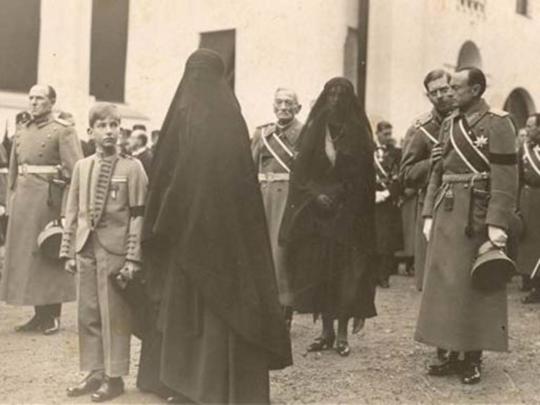
This photo released by the Royal Archives in Serbia shows, from left, King Peter II, Queen Maria, Prince Arsen, Princess Olga, King Carol II of Romania and Prince Paul at the funeral of HM King Alexander I on Oct. 18, 1934.
#king carol ii of romania#prince paul of yugoslavia#princess olga of yugoslavia#princess paul of yugoslavia#queen maria of yugoslavia#king peter ii of yugoslavia#prince arsen of yugoslavia#yugoslavian royal#yugoslavian royal family#yugoslavian royalty#1934#funeral#prince paul of serbia
26 notes
·
View notes
Text

Princess Olga of Greece and Prince Paul of Yugoslavia at their wedding.
Olga was the eldest daughter of Grand Duchess Elena Vladimirovna and Prince Nicholas of Greece. She spent time in Russia during her childhood, visiting her grandparents, Grand Duke Vladimir Alexandrovich and Grand Duchess Maria Pavlovna, and occasionally played with the younger children of Nicholas II; in his memoirs, Prince Nicholas described Olga and her sister Elizabeth as being "great chums" with Alexei especially.
Prince Paul also had a Russian mother, noblewoman Princess Aurora Pavlovna Demidova di San Donato. She divorced Paul's father, Prince Arsen, when Paul was just a small child.
#romanov relatives#greek royal family#yugoslavian royal family#olga of greece#paul of yugoslavia#weddings#old newspapers#my collection
33 notes
·
View notes
Text
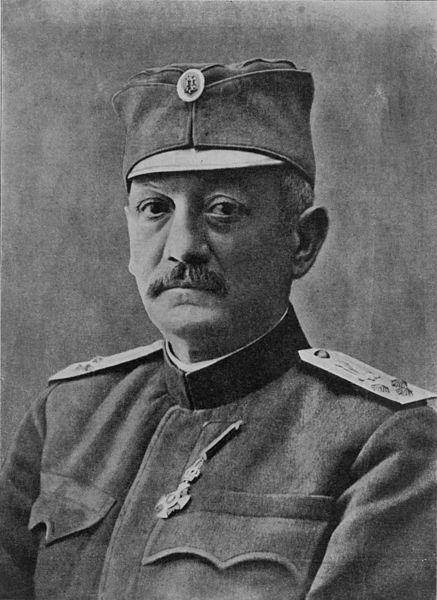
Prince Arsen of Yugoslavia.
He is ancestor of the current cadet branch of the Royal Family which ruled Yugoslavia until 1945.
9 notes
·
View notes
Text
Kotor Old Town: 1350 Steps to The Crown

Kotor Old Town is rising star of Montenegro. For a few years, Kotor became more and more people among the traveller. Kotor is a very small city with only 13510 residents. City is located at the Gulf of Kotor and more popular than the capital of Montenegro, Podgorica. Kotor Old town is surrounded by fortifications built by the Republic of Venice. History of the town dates back to the Roman era. In this post, you will discover this fascinating city of one of the youngest countries in the world.

Panoramic view of the Bay of Kotor from the Kotor Fortress (Source).
History of Kotor
Early History of Kotor
Kotor has a long-standing and complex history and maybe the most fascinating one when compared to the other major tourist spots. Name of the Kotor first appeared in the Roman artefacts. Those times (168 BC) the city is known as Acruvium, Ascrivium or Ascruvium and was the part of the Dalmatia. Kotor always fortified by its conquerors because of the geostrategic location of the settlement. Around 535 Emperor Justinian built a fortress over the town (Ascrivium) after the expelling the Ostrogoths. After a quite long time from the Emperor Justinian Kotor was plundered by the Saracens in 840 and fortified more and more toward to the peak of Saint Ivan by the Constantine VII Porphyrogennetos in the 10th century. Between 1002 and 1143 Kotor was under influence of the First Bulgarian Empire.
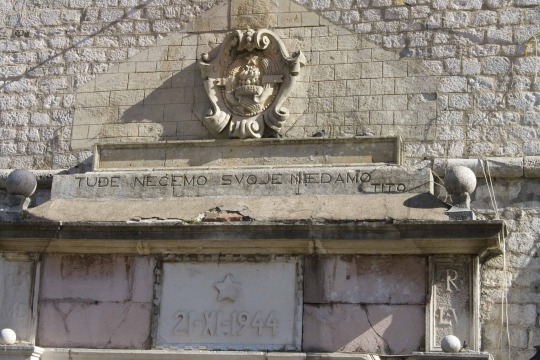
The entrance of old town Kotor with post-World War II sign "What belongs to others we don't want, ours we don't give" (Source).
Venice, Ottoman Rule and Modern Times
Kotor conquered by the Grand Principality of Serbian in 1185 and Serbs ruled the city until the year of 1391. After the death of Tvrtko (King of Bosnia) in 1391, Kotor became fully independent until the threat of conquered by the Ottomans. Kotor asked for help from Venice when the Ottoman threat rose up. The city was part of Venetian Albania between 1420 to 1797. In this time frame Ottomans besieged the city two times, 1538 and 1657. More than 4 century Venice made great contribution to the Kotor's current heritage. During these 4 centries city was own time-to-time by the Ottomans also.

You will get lost the fascinating streets of Old Town (Source).
After the Treaty of Campo Fomio in 1797, Kotor passed to the Habsburg Monarch but in 1805 became part of the French Empire's client state. Even Russian held the city for a while but in 1810 the city return to the Kingdom of Italy. Kotor became one of the main bases of the Austro-Hungarian Navy and home of the Austrian Fifth Fleet. After the end of World War I (The Great War), Yugoslavia founded an the city became part of it. Kotor got it name from that date. During the tensions of World War II, Kotor annexed by Italy and stayed that way between 1941 and 1943. It is complicated, right? Kotor has a stunning heritage because of its historical heritage.
Where is Kotor Old Town?
Kotor is only 85 km away from the Podgorica, capital of the Kotor. If you want to go to the Kotor Old Town by plane you should go to Podgorica Airport. The nearest airport to the Kotor is the Tivat Airport but it will hard to find a flight to there. It is also possible to go to the Kotor Old Town by renting a car from nearest major cities like Tiran, Pristine or Skopje.
How to Go to Kotor Old Town?
Unfortunately, there is no train to the Kotor from any city because of the channelling geography of the area. You should rent a car, taxi or buy a ticket for the buses. Don't worry buses are good to travel and trusted. You should find the bus routes to the Kotor Old Town from other cities.
Podgorica to Kotor: 14 - 20 Euro
Tiran to Kotor: 13 - 19 Euro
Belgrade to Kotor: 19 - 40 Euro
Skopje to Kotor: 24 - 35 Euro
Budva to Kotor: 11 - 17 Euro
Kotor Old Town and Fortress
When you enter the gate of the Kotor Old Town you will start time travel through history. Kotor Old Town have multiple historical places to see during your time there. At the main entrance of the Kotor Old Town, you will a couple of places to drink coffee or eat a pizza with shops and other places. Before starting to move up to the top I'm strongly suggesting to walk around the street for a while. You need to heat your leg, you will need it :) Gate of the Kotor Old Town opens at 08.00 am in the morning. If you go to the Kotor during summer you will think to go to the top early hours in the morning or evening to avoid the excessive heat.
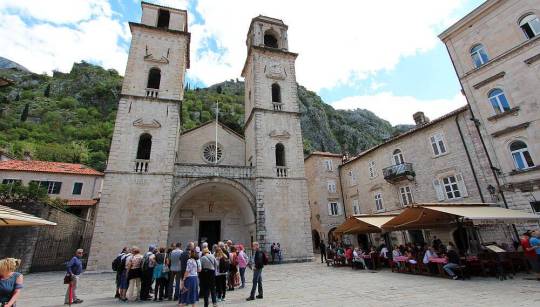
The main entrance of the Kotor Old Town (Source).
There is no tickets or price to enter the Kotor Old Town. Also, you don't need a guide to visit the town. There are multiple apps or maps for the Kotor Old Town. You will also find maps at the entrance. In this link, you will a really good map and information about the trail to the top. There are three entrances to the old town; South Gurdic Gate, Main Sea Gate and North River Gate. You will probably use the Sea Gate to enter. Before you start to walk to the top you may want to visit some important spots in the town. You will find the list (a long list) of them below;
Riva Bastion
Campana Tower
Citadella
Valier Bastion
Corner Bastion
Gurdic Bastion
St. Tryphon's Cathedral
St. Nicholas Church
St. Lucas Church
St. Mary's (Blessed Ozana)
St. Paul's Church
Santa Anna's Church
St. Michael's Church
St. Josep's Chruch
St. Francis Monastery
Santa Clara's Monastery
Arms Square
Flour Square
Karampana Square
Town Tower Clock
Prince's Palace
Old Town Hall
Venetian Arsenal
Town Hall
Historical Archives
Venetian Barracks
Austrian Prison
Drago Palace
Grgurina Palace
Pima Palace
Macchin House
Lombardic Palace

The clock tower of the Kotor Old Town (Source).
Time to Start to Walk
If you spend time for a while in the Kotor Old Town you will start to walk to the top. There will an 8 Euro entrance fee to the trail road to the top. There is around 1350 step that you have to climb. Don't worry there are multiple places to rest while climbing. There are 3 different routes for the trail to the top and down. There are two important place in this trail, Lady of Remedy Chruch and St. John's Castle. It will be easy to reach the church but the castle will be a little tiring for you. If you're confident don't use the red route to go down. Because on some part of it there are no stairs or road to follow. You just need to jump over the wall or make your own way through the trees.

The red route would be really challenging (Source).
Lady of Remedy Chruch
The year 1435 was a sad page of the history of Kotor. Plague during the year wiped out most of the population of the Kotor Old Town. People of Kotor built the Lady of Remedy Church to have God's protection over them. Your first aim should be reached to the Lady of Remedy Chruch. After around 500 steps you will reach the church. It is not a big but beautiful one. Lady of Remedy Chruch was built during the 15th century. The church has a baroque style with a gothic arch. Three bells of the church are quite famous because they made in the bell foundry De Poli in Vittorio Veneto, Italy. You will see a crypt inside the church. That crypt is related to Bolic family of Kotor. There is also the tomb of count Anton Lukovic (Kotor citizen) outside of the church.

You will rest and enjoy the view for a while (Source).
St. John's Castle
You need to climb around 800 steps more to reach the St. John's Castle from the Lady of Remedy Chruch. St. John's Castle is located 260 meters high from the sea level. Unfortunately, St. John's Castle is a crumbled ruin but it is still possible to climb over it and enjoy the view through the Kotor Old Town and stunning nature of the region. There is a plan for the restoration of the castle, pathways, sightseeing spot and other thing but it didn't start yet.
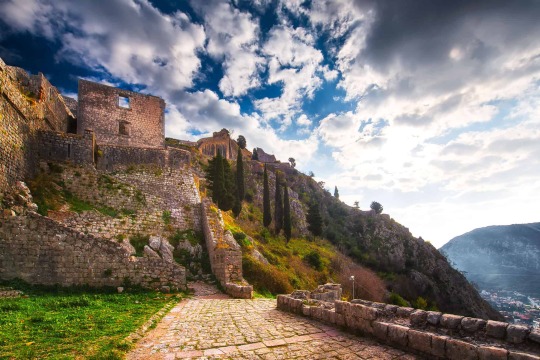
Ruins of the St. Jonh's Castle (Source).
Suggestions for Visiting Kotor Old Town
It better starts early to climb up.
Take a couple of bottle of water. You won't find anywhere to buy during the trail. Maybe there will be some people who will be selling it but not for sure.
Climbing will take around 2 hours, be prepared for that.
Don't forget to wear suitable clothes and especially shoes.
Enjoy the view!
If you ever visited or thinking to visit the Kotor Old Town please share your experiences and questions on the comment section to help others.
Read the full article
0 notes
Link
0 notes
Text
Expert: Trump takes on the world How to explain the welter of contradictions in US politics these days? * Trump’s enthusiasm for peace with Russia vs his acceptance of Cold War II with Russia, launched even as Trump declared victory in 2016. * Trump’s virtually declaration of war against the mouse, Canada, next door, with his cutting insult to Justin Trudeau as weak and dishonest, as he left the summit early and refused to endorse its free trade plea. * Trump’s original enthusiasm for pulling out of Syria and elsewhere, pursuing an old fashion Republican isolationism, vs his sudden flurry of bombings in Syria recently and the threat of invasion of others (Iran, North Korea, Venezuela). * Trump’s dumping of the carefully crafted nuclear agreement with Iran, renewing sanctions and threats in the face of world opposition, both domestic and foreign (ok, the Zionists are happy, but no one else). * Trump’s unsolicited ‘deal of the century’ with Israel-Palestine. The Russians are coming There are behind-the-scenes forces at work with Russia at the centre. Obama’s and the western media’s human rights spat with Russia over Ukraine and Crimea are not important to the long term strategy of the neocons. Trump and his deep state backers understand this. Kissinger admitted it in June. They want Russia back in a new G-8, as Trump so loudly proclaimed at the G-7 in Quebec in June. But a Russia on the defensive is also in their interests, the better to make Russia bow more respectfully to US world hegemony in any grand compromise. Good cop, bad cop. Trudeau was comforted by his Euro colleagues when called a liar by the bully, but Trump has no time for wimps,* pious words attacking Russia or promoting gender equality and the environment. The ‘grand strategy’ of the Pentagon and neocons is about world control. “His message from Quebec to Singapore is that he is going to meld the industrial democracies to his will — and bring back Russia,” said Steve Bannon, Trump’s former campaign and White House adviser. Bannon said China is “now on notice that Trump will not back down from even allies’ complaints in his goal of America First.” What Europeans deride now as “G-6 plus one” would become again the G-8. Russia will dump Iran and China, and be a nice US puppet. There is a reason that neoconservatives are said to be the heirs of Trotsky: Trotsky wanted to export revolution to all countries, whether they were ready for it or not (with the subsequent goal of destroying national boundaries and traditional cultures); Trump’s neoconservatives want to spread neocon ideology to all countries (e.g., globalism, the dominance of western corporations and markets, ‘democracy’, relativising traditional society). The dialectic has come full-circle. In a weird sort of way, the (Christian) US is the anti-Christ to the (atheist) Soviet Christ. Both are/were radical universalists. Putin understands this and is neither a communist nor is he likely to take the neocon bait, as did Gorbachev-Yeltsin. Neither is Kim Jong-un. The Palestinians are coming Trump enthusiast Leon Haider praises Trump’s rejection of a “make-believe ‘peace process’”, replacing it with his “deal of the century”, that counts on moderate Arabs convincing the Palestinians to “take the route towards coexistence” with Israel that will “eventually lead to a peace deal, the deal of the century.” Bully the Palestinians into a deal that they can’t refuse. Trump somehow thinks this bullying will succeed where all of his predecessors have failed. But the so-called moderate Arabs are anything but. * Saudi Arabia is a feudal fiefdom, the source and inspiration of al-qaeda/ISIS through Wahhabism and petrodollars, provided discretely both officially and unofficially (by dissident princes). Its list of human rights violations grows daily, presently torturing its old rival Yemen for no apparent reason. * Egypt is being run into the ground by a vicious dictator-general. * Turkey, the most important actor, is ignored and isolated over the Kurdish problem. * Jordan is in upheaval protesting IMF-backed price increases and a new tax reform law. These countries are hardly poster children for the advantage of being a friend to the US and Israel. The other Arab country, Syria, just barely survived the US-backed insurgency and is back in the anti-imperialist fold (i.e., pro-Iran/ Russia) after 7 brutal years when it was betrayed by ‘moderate Arabs’ (not to mention Turkey). It is my choice as a ‘moderate Arab’, but will continue to oppose the US ‘grand stategy’ for the region, along with a chastened Turkey. Where is the grand strategy here? Bin Salman personally delivered Trump’s secret ‘deal of the century’ to Abbas, who refused to even open the envelope. For Trump’s ‘moderate Arabs’, read: Shia-hating Sunnis, led by King Bin Salman. Their hatred is mostly sour grapes for Iran’s proud defiance of US dictates. Arabs were traditionally the freest of peoples, the heirs of the Prophet, who was no friend of Rome. Those Sunnis would dump the US in a flash if they didn’t need Bin Salman’s billion-dollar bribes, and if there was another patron to feed them. Do they help the US achieve world control, the underlying strategy? Only Israel is more or less happy. It is their ‘grand strategy’ for the Palestinians that is closer. Its goal appears to be to annex the occupied territories unilaterally, set up a Quisling Palestinian Authority to police what’s left of the West Bank, under Israeli control. A variation would be to force Palestinians and Jordan to make the occupied territories Jordanian (but policed by Israel) and make all Palestinians ‘Jordanians’, after first taking most of the desirable bits for Israel. If the Israeli Arabs cause too much fuss, they too can go to their new ‘homeland’ (Jordan West Bank), along with Gazans, once Gaza is declared uninhabitable. Postmodern ethnic cleansing. Not so many deaths, wipe out the refugee problem at a stroke, dispense with the pesky ‘return’ problem. That would leave Iran or Iran/Syria as the target of Israel’s next and final war, not the Palestinians — and the Sunni Arab world will watch from the sidelines, and would not be unhappy to see Iran destroyed. That would allow Israel to proceed with its ‘final solution’ for the Palestinians, once Iran is out of the picture, even as these ‘moderate Arabs’ squawk (or are overthrown). The Iranians are (not) coming Trump’s summit with Kim Jong-Un in Singapore looks and tastes like Nixon in China, but was it a fraud, the icing laced with artificial sweetener or maybe arsenic? Surely Kim realizes that he must hold out for the closure of US bases in South Korea, as only that could possibly guarantee denuclearization of the peninsula. And why no mention of Iran in all the hype, let alone a stopover in Tehran, if denuclearization is the real issue? It appears that by allowing the interventions in Yugoslavia, Libya, Afghanistan, Iraq, etc. (R2P responsibility to protect), the so-called international community did only one thing, it created more possibilities for new interventions, interventions that promote western control; i.e., imperialism. Russia will have no truck with this, as it is not interested in promoting western imperialism. Libya was the last straw, and instead, Russia moved on its own to help stabilize Syria without these dubious ‘protectors’. The disasters these interventions have resulted in means it is unlikely they can be repeated, despite Pence’s warning to Kim that he might end up “like Libya”. Probably Iran is safe, given Russia. A real strategy would involve making peace with Iran, not war. War is the way imperialism deals with problems, and is what US ‘allies’ Saudi Arabia and Israel want for their own reasons, which have nothing to do with peace or US security. Both the Saudis and Israel benefit(ed) from terrorism directed at US targets and celebrate them. (To the Saudis, the Americans are kufar and deserve to die. Remember Netanyahu’s comment on 9/11 “It’s very good”?). [Update: Trump pulled yet another fast one on July 31, 2018, offering to meet Rohani, but the jury is still out.] Peace with Iran would knock some sense into both the Saudis and Israel, and would curb the lust for war. The Saudis would fume, maybe instigate some terrorism themselves, but they are so tightly knit in the US orbit, this could be managed. Israel has its Jerusalem but nowhere to turn to. Israel’s life blood — Jewish Americans — are increasingly hostile to Israel, given its murderous policy of expansion. The fallout from such a truly ‘grand strategy’ would benefit both the US and the world, as the US and Russia revive their ‘grand compromises’ of the past (WWII, 1960s–70s detente). A ‘grand compromise’ for Turkey’s, Iraq’s and Iran’s Kurds could finally be addressed. Devastated Syria and Iraq would not be distracted by US-Iranian hostility and would rebound quickly. Iran’s only pretension internationally is to help the Palestinians, though the US did leave a vacuum in Iraq with the destruction of that state, and Iran is now playing its logical role as supporter of Shia next door and as a good neighbour. “Don’t hold your breath,” writes Stephen Walsh in Foreign Policy. Making peace with Iran would require Trump (and Congress) to ignore the lobbying and propaganda emanating from the Israeli and Saudi lobbies. But after the recent Israel massacre of Gazans, and given the ordinary American’s distaste for the Saudis and their massacre of Yemenis, there is no better time. Congress is not lying down. The sole Muslim congressman, Keith Ellison, put together a nonpartisan amendment of the National Defense Authorization Act to specifically prevent the president from launching war against Iran without congressional authorization. Even if the Ellison amendment survives the Senate, Trump could ‘pull a Trump’ and violate it. He could target Iranian individuals as “suspected terrorists” on his global battlefield and/or attack them in Iran with military force under his new targeted killing rules. It does not prohibit the expenditure of money to attack Iran. Nor does it proscribe the use of sanctions against Iran. But it shows that Trump does not have a blank check for his ‘grand strategies’. Jewish Americans hold the key Nor are the ‘good’ Jews in the US, energized by Israeli atrocities, silent anymore. A groundswell of Jewish protests is making room for the rest of Americans to brave the Zionist thought police. It is complicated piecing Trump’s grand strategy together, partly because he is a loose cannon, with his own self-aggrandizing agenda, and partly because of the chaotic conditions and opposing forces elsewhere. He is gambling on using good-cop/ bad-cop with Russia, plain old bad-cop with Iran and North Korea, to achieve his ends. Gunboat diplomacy. The US (and more so Trump’s) unreliability as a representative of US policy, willing to tear up treaties, makes it unlikely that Trump’s fish will bite. Israel’s strategy is also unlikely to prevail. Young US Jews** are already getting arrested protesting Israeli actions, much like they did in the 1950s–60s when they virtually led in the civil rights movement for blacks, and again in the 1980s, when they backed the anti-apartheid struggle. Then, their Jewishness was downplayed, but in this last war, they hold the trump card to successfully fight Israel, and must speak out for peace. As for Russia and Iran, Trump finally got some cajones and defied his backstabbers, not only meeting Putin, but out of the blue declaring he will meet Iran’s President Rohani, “no pre-conditions”. This is now a ritual for him facing off against his ‘enemies’: threaten to invade (Kim the Rocketman, NEVER, EVER THREATEN THE UNITED STATES AGAIN OR YOU WILL SUFFER CONSEQUENCES THE LIKES OF WHICH FEW THROUGHOUT HISTORY HAVE EVER SUFFERED BEFORE) and then coolly agree to negotiate. As for drama and idiocy, ‘Who could ask for anything more?’ *** *Trudeau is indeed weak and dishonest, as Trump’s advisers told him after perusing his many broken promises as prime minister ** IfNotNow is the latest, composed of Jewish teens. *** Thank you, Gershwin. http://clubof.info/
0 notes
Text
St George’s Church (Serbian: Црква Св. Ђорђа) also known as Oplenac (Опленац), is the mausoleum of the Serbian and Yugoslavroyal house of Karađorđević located on top of the Oplenac Hill in the town of Topola, Serbia. The church of Oplenac was founded by King Peter I of Yugoslavia. Many members of the royal house are buried in the church, in the crypt beneath the church, or in the church yard.
Apart from the two tombs inside the church (Karađorđe’s in the southern apse; and Peter I in the northern apse), there are 26 other members of the dynasty whose eternal place of rest is in this mausoleum. Six generations of the Karađorđević family have been buried in this church:
The first generation: Marica Živković, Karađorđe’s mother.
The second generation: Karađorđe (in the church) and his wife Jelena Jovanović (1764–1842).
The third generation: Karađorđe’s son Alexander and his wife Persida Nenadović (1813–1873).
The fourth generation: Alexander and Persida’s nine children. As follows: Kleopatra (1835-1855), Aleksije (1836-1840), Svetozar (1841-1847), Jelena (1846–1867), Andreja (1848–1864), Jelisaveta (1851–1852), Dorde (1856–1888), Arsen, and Peter I (in the church) and his wife Ljubica also known as Zorka (she is buried in the crypt). Out of the ten children of Prince Alexander and Princess Persida, only their oldest daughter, Poleksija (1833–1914), was not buried here.
The fifth generation, Peter I and Zorka’s children: Milena (1886–1887), George and his wife Radmila Radonjić (1907–1993), Alexander I and his wife Maria and Andrija (1890–1890, lived only for 23 days). And also Prince Arsen’s son Paul and his wife Olga.
The sixth generation: King Alexander I and Queen Maria’s children: Peter II and his wife Alexandra, Tomislav, and Andrew. And also Prince Paul‘s sons Nikola and Alexander.
Out of the 28 tombs of the Karađorđević dynasty, six of them belong to rulers: Supreme Leader Karađorđe, Prince Alexander, King Peter I, King Aleksandar I, Prince Paul, and King Peter II. It is an important place of Serbian history. On 6 October 2012, Prince Paul, his wife Olga and his son Nikola were all buried here after their remains were exhumed from the cemetery in Lausanne, and returned to Serbia.
On 26 May 2013, Queen Maria, her sons King Peter II and Prince Andrew, and Peter II’s wife Alexandra, were all buried here after their remains were exhumed from Frogmore in Britain, the Saint Sava Monastery in Libertyville, Illinois, the cemetery of New Gračanica, also in Illinois, and Tatoi Palace in Greece respectively, and returned to Serbia
The Serbian Royal family & The Oplenac Mausoleum
Oplenac – St George’s church visit St George's Church (Serbian: Црква Св. Ђорђа) also known as Oplenac (Опленац), is the
0 notes
Text
Royal Wedding on 8 June 1922 in Belgrade (part 1).
King Alexander I of Serbia (33) and Princess Maria of Romania (22).
The bridegroom was the youngest child of King Peter I of Serbia and his wife Princess Zorka of Montenegro who sadly passed away when Alexander was only one year and three months old.


The bride was the second born daughter of King Ferdinand I of Romania and his wife, Princess Marie of Edinburgh.
The bride arriving for her wedding, her father and bridesmaids are welcoming her.
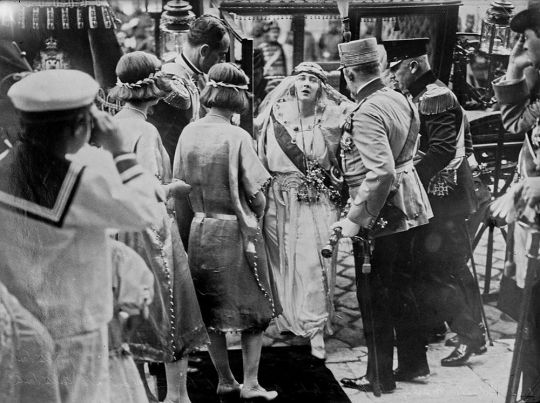
The wedding ceremony


The bride with her sister and first cousin.
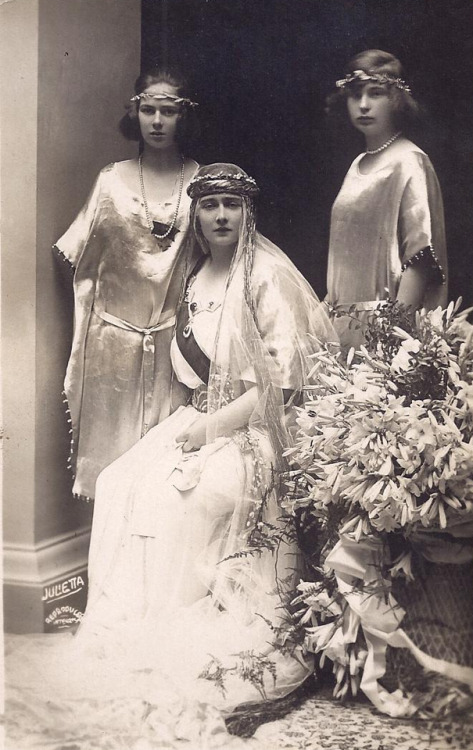
The lavish royal wedding to Princess Maria of Romania was intended to cement the alliance with Romania, a fellow "victor nation" in World War I which like Yugoslavia had territorial disputes with the defeated nations like Hungary and Bulgaria. For Alexander, the royal wedding was especially satisfactory as most of the royal families of Europe attended, which showed that the House of Karađorđević, a family of peasant origins who were disliked for slaughtering the rival House of Obrenović in 1903, were finally accepted by the rest of European royalty.

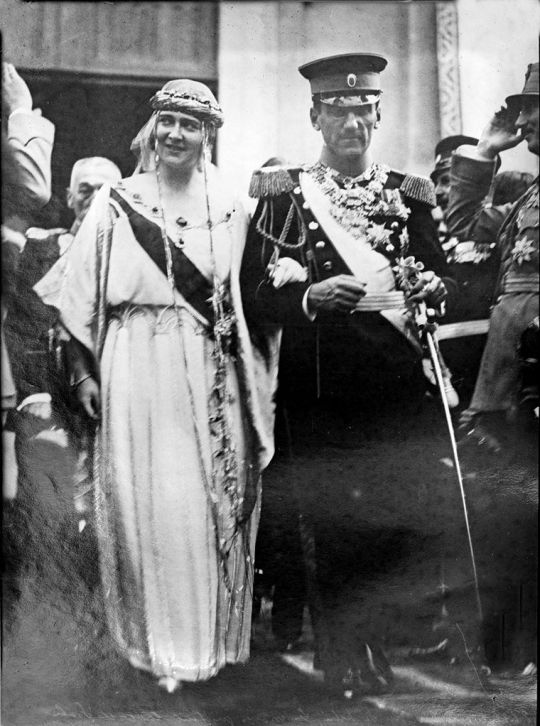


#queen marie of romania#king ferdinand i of romania#king alexander i of yugoslavia#princess maria of romania#queen maria of yugoslavia#princess ileana of romania#princess kira kirillovna of russia#1922#1920s#royal weddings#prince arsen of serbia#yugoslavian royal family
42 notes
·
View notes
Text

Princess Aurora Pavlovna Demidova (1873-1904) in 1892.
A princess with a troubled love life
She was the eldest daughter of Pavel Pavlovich Demidov, the 2nd Prince of San Donato , and his second wife, Princess Elena Petrovna Trubetskoy. She was named after her paternal grandmother, Swedish-Finnish philanthropist Aurora Karamzina , who was married to Pavel Nikolayevich Demidov .
Having lost her father early, she was raised by her mother. She lived with her in Kiev and Odessa. Elena Petrovna passed on her beauty to all her children, but they inherited the explosive and stormy character from their father. Aurora Pavlovna was her mother's favorie child and during her short life caused her mother lots of worry.
At the age of 18, she married Arsen Karageorgievich (1858-1938), Prince of Serbia. Their wedding took place on May 1, 1892 in Helsingfors in the Orthodox Assumption Cathedral . This marriage wasn't happy, it was difficult to imagine people of a more different temperament together . Soon after the birth of their son Paul (1893-1976), the future regent of Yugoslavia, the couple separated.
Prince Arsene preferred to live in Paris, where he was known for his gambling addiction. Aurora Pavlovna lived in St. Petersburg and led an eventful life. Wanting to be free from any obligations towards her son, she sent him at the age of one year (in 1894) to his uncle, Prince Peter Karageorgievich, in Geneva . Subsequently, Prince Paul saw his mother only twice, in 1898 and in 1900.
Aurora Pavlovna was known for her tumultuous love life. In 1894, there was much talk in St. Petersburg society about her relationship with the young Baron Manteuffel . She wanted to marry him and thought about a divorce from her husband, but such a situation was not part of Manteuffel's plans. The result of this affair was the birth of twins, Sergei (1895-1912) and Nikolai (1895-1933), although they bore the surname of Prince Arsen, he did not recognize them as their children. The divorce proceedings began, which ended on December 26, 1896.
By the time of the divorce, Aurora Pavlovna was in a relationship with the Palatine Count, Nikollo Giovanni Maria di Noghera (1875-1944) and had a son, Albert (1896-1971) from him. In his birth certificate, he was recorded as the child of a 21-year-old Count di Noguera from an unknown woman.
They married in November 4, 1897 in Genoa. Aurora, gave birth to a daughter, Elena Aurora di Noguera (05.22.1898-12.10.1967) and two more sons Giovanni and Amedeo (1902-1982).
In June 1904, 30-year-old Aurora Pavlovna, abandoned by her husband, suddenly died. According to one version, she poisoned herself with arsenic . Her ashes were buried according to the Orthodox custom only on September 22, 1906 in the Church of the Nativity of the Russian Embassy in Florence. The cause of death was called heart disease. She was buried in a special chapel in the cemetery in Milan . Her children were taken into custody by a childless aunt Maria Pavlovna Abamelek-Lazareva. According to Sofya Illarionovna Demidova, who highly valued her, Aurora Pavlovna was a good and good person who did not want anyone to harm, but only with an unfortunate fate.
Aurora Demidova is often mentioned in works on the history of the industrial dynasty of the Demidovs: her share of property was the sixth and most modest (50 out of 1050 shares into which the state of the Demidovs shared). After her death, and this share was blurred between the eight heirs; upon entering into inheritance rights, her Italian husband became a co-owner of the Nizhny Tagil and Lunevsky factories. Villa Pratolino was inherited by his son Paul. A rare rose variety, Comtesse de Noghera (1902), was named after Aurora.
33 notes
·
View notes
Text
Kotor Old Town: 1350 Steps to The Crown

Kotor Old Town is rising star of Montenegro. For a few years, Kotor became more and more people among the traveller. Kotor is a very small city with only 13510 residents. City is located at the Gulf of Kotor and more popular than the capital of Montenegro, Podgorica. Kotor Old town is surrounded by fortifications built by the Republic of Venice. History of the town dates back to the Roman era. In this post, you will discover this fascinating city of one of the youngest countries in the world.

Panoramic view of the Bay of Kotor from the Kotor Fortress (Source).
History of Kotor
Early History of Kotor
Kotor has a long-standing and complex history and maybe the most fascinating one when compared to the other major tourist spots. Name of the Kotor first appeared in the Roman artefacts. Those times (168 BC) the city is known as Acruvium, Ascrivium or Ascruvium and was the part of the Dalmatia. Kotor always fortified by its conquerors because of the geostrategic location of the settlement. Around 535 Emperor Justinian built a fortress over the town (Ascrivium) after the expelling the Ostrogoths. After a quite long time from the Emperor Justinian Kotor was plundered by the Saracens in 840 and fortified more and more toward to the peak of Saint Ivan by the Constantine VII Porphyrogennetos in the 10th century. Between 1002 and 1143 Kotor was under influence of the First Bulgarian Empire.

The entrance of old town Kotor with post-World War II sign "What belongs to others we don't want, ours we don't give" (Source).
Venice, Ottoman Rule and Modern Times
Kotor conquered by the Grand Principality of Serbian in 1185 and Serbs ruled the city until the year of 1391. After the death of Tvrtko (King of Bosnia) in 1391, Kotor became fully independent until the threat of conquered by the Ottomans. Kotor asked for help from Venice when the Ottoman threat rose up. The city was part of Venetian Albania between 1420 to 1797. In this time frame Ottomans besieged the city two times, 1538 and 1657. More than 4 century Venice made great contribution to the Kotor's current heritage. During these 4 centries city was own time-to-time by the Ottomans also.

You will get lost the fascinating streets of Old Town (Source).
After the Treaty of Campo Fomio in 1797, Kotor passed to the Habsburg Monarch but in 1805 became part of the French Empire's client state. Even Russian held the city for a while but in 1810 the city return to the Kingdom of Italy. Kotor became one of the main bases of the Austro-Hungarian Navy and home of the Austrian Fifth Fleet. After the end of World War I (The Great War), Yugoslavia founded an the city became part of it. Kotor got it name from that date. During the tensions of World War II, Kotor annexed by Italy and stayed that way between 1941 and 1943. It is complicated, right? Kotor has a stunning heritage because of its historical heritage.
Where is Kotor Old Town?
Kotor is only 85 km away from the Podgorica, capital of the Kotor. If you want to go to the Kotor Old Town by plane you should go to Podgorica Airport. The nearest airport to the Kotor is the Tivat Airport but it will hard to find a flight to there. It is also possible to go to the Kotor Old Town by renting a car from nearest major cities like Tiran, Pristine or Skopje.
How to Go to Kotor Old Town?
Unfortunately, there is no train to the Kotor from any city because of the channelling geography of the area. You should rent a car, taxi or buy a ticket for the buses. Don't worry buses are good to travel and trusted. You should find the bus routes to the Kotor Old Town from other cities.
Podgorica to Kotor: 14 - 20 Euro
Tiran to Kotor: 13 - 19 Euro
Belgrade to Kotor: 19 - 40 Euro
Skopje to Kotor: 24 - 35 Euro
Budva to Kotor: 11 - 17 Euro
Kotor Old Town and Fortress
When you enter the gate of the Kotor Old Town you will start time travel through history. Kotor Old Town have multiple historical places to see during your time there. At the main entrance of the Kotor Old Town, you will a couple of places to drink coffee or eat a pizza with shops and other places. Before starting to move up to the top I'm strongly suggesting to walk around the street for a while. You need to heat your leg, you will need it :) Gate of the Kotor Old Town opens at 08.00 am in the morning. If you go to the Kotor during summer you will think to go to the top early hours in the morning or evening to avoid the excessive heat.

The main entrance of the Kotor Old Town (Source).
There is no tickets or price to enter the Kotor Old Town. Also, you don't need a guide to visit the town. There are multiple apps or maps for the Kotor Old Town. You will also find maps at the entrance. In this link, you will a really good map and information about the trail to the top. There are three entrances to the old town; South Gurdic Gate, Main Sea Gate and North River Gate. You will probably use the Sea Gate to enter. Before you start to walk to the top you may want to visit some important spots in the town. You will find the list (a long list) of them below;
Riva Bastion
Campana Tower
Citadella
Valier Bastion
Corner Bastion
Gurdic Bastion
St. Tryphon's Cathedral
St. Nicholas Church
St. Lucas Church
St. Mary's (Blessed Ozana)
St. Paul's Church
Santa Anna's Church
St. Michael's Church
St. Josep's Chruch
St. Francis Monastery
Santa Clara's Monastery
Arms Square
Flour Square
Karampana Square
Town Tower Clock
Prince's Palace
Old Town Hall
Venetian Arsenal
Town Hall
Historical Archives
Venetian Barracks
Austrian Prison
Drago Palace
Grgurina Palace
Pima Palace
Macchin House
Lombardic Palace

The clock tower of the Kotor Old Town (Source).
Time to Start to Walk
If you spend for a while in the Kotor Old Town you will start to walk to the top. There will an 8 Euro entrance fee to the trail road to the top. There is around 1350 step that you have to climb. Don't worry there are multiple places to rest while climbing. There are 3 different routes for the trail to the top and down. There are two important place in this trail, Lady of Remedy Chruch and St. John's Castle. It will be easy to reach the church but the castle will be a little tiring for you. If you're confident don't use the red route to go down. Because on some part of it there are no stairs or road to follow. You just need to jump over the wall or make your own way through the trees.

The red route would be really challenging (Source).
Lady of Remedy Chruch
The year 1435 was a sad page of the history of Kotor. Plague during the year wiped out most of the population of the Kotor Old Town. People of Kotor built the Lady of Remedy Church to have God's protection over them. Your first aim should be reached to the Lady of Remedy Chruch. After around 500 steps you will reach the church. It is not a big but beautiful one. Lady of Remedy Chruch was built during the 15th century. The church has a baroque style with a gothic arch. Three bells of the church are quite famous because they made in the bell foundry De Poli in Vittorio Veneto, Italy. You will see a crypt inside the church. That crypt is related to Bolic family of Kotor. There is also the tomb of count Anton Lukovic (Kotor citizen) outside of the church.
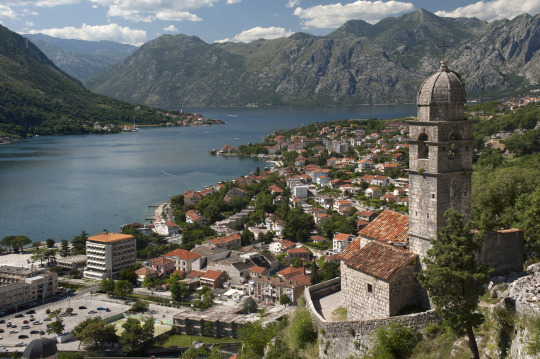
You will rest and enjoy the view for a while (Source).
St. John's Castle
You need to climb around 800 steps more to reach the St. John's Castle from the Lady of Remedy Chruch. St. John's Castle is located 260 meters high from the sea level. Unfortunately, St. John's Castle is a crumbled ruin but it is still possible to climb over it and enjoy the view through the Kotor Old Town and stunning nature of the region. There is a plan for the restoration of the castle, pathways, sightseeing spot and other thing but it didn't start yet.

Ruins of the St. Jonh's Castle (Source).
Suggestions for Visiting Kotor Old Town
It better starts early to climb up.
Take a couple of bottle of water. You won't find anywhere to buy during the trail. Maybe there will be some people who will be selling it but not for sure.
Climbing will take around 2 hours, be prepared for that.
Don't forget to wear suitable clothes and especially shoes.
Enjoy the view!
If you ever visited or thinking to visit the Kotor Old Town please share your experiences and questions on the comment section to help others.
Read the full article
0 notes